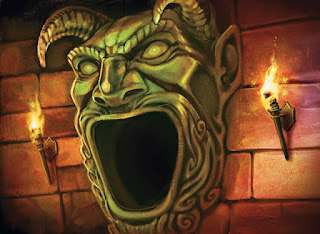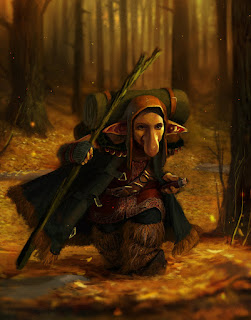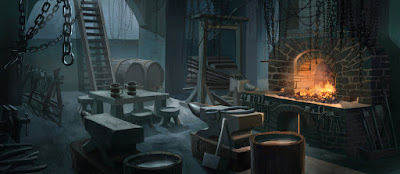 |
| Staying Lit in the Icy Tundra |
This story is part 6 of a series. This campaign was discontinued.
| Part 1 | Part 2 | Part 3 | Part 4 | Part 5 | Part 6 | Part 7 | Part 8 | Part 9 | Part 10 | Part 11 | Part 12 | Part 13 | Part 14 | Part 15 | Part 16 | Part 17 |
Storm King's Thunder: Saving Bryn Shander
Cast of Characters
Megan: Cecelia Sondheim, human bard, a Harper hoping for a bright future!
Cody: Rolen Dundragon, half-elf Warlock of the Archfey, a scoundrel with a heart of gold
Cait: Mialee Galanodel, elf ranger, from a distant land and doesn't have personal space boundaries
We left off last session with Cecelia meeting Beldora, a Harper agent with a lot of information and connections. Beldora promoted Cecelia to the rank of Harpshadow, and gave her a Sending Stone so they could communicate. Beldora is now Cecelia's mentor.
The group is in the distant northern town of Bryn Shander, part of the Ten-Towns allegiance in Icewind Dale. They came this way to let the Sheriff, Markham Southwell, know that his sister died during a Giant attack in Nightstone.
First, however, the heroes decided to warm up and grab some drinks in the local tavern with Beldora. The players walked in, dropped 20 gold in the barkeep's pocket, and asked to be taken care of. This sent a flurry of whispers through the tavern. Who were these strangers, and what were they doing throwing around that kind of money in a tavern?
This happened because I started listing prices for food and drinks. That might have been a little too pedantic on my part, but I liked getting the chance for the players to make a splash in the town. Fortunately, I had prepared for this by having each player write a rumor about the other two!
Rumors began to fly through the tavern. People thought Mialee glittered so much because she was a vampire trying to use a spell to protect her from sunlight. Rumors flew that Cecelia's stone chest, which she had earned in a close call with a dragon, was actually from a wizard she had turned down on a date. And some old housewives assumed Rolen's magical snake staff could hypnotize people.
Amidst the flying gossip, an armored man with silver in his hair wandered up to the table. He introduced himself as a member of the Order of the Gauntlet, Sir Baric Nylef. He was searching for a dwarven rogue, Worvil "The Weevil" Forkbeard, and wanted to know if the party had seen or heard anything, being from out of town.
As soon as he placed the wanted poster on the table, Mialee recognized the dwarf in question. It was Larg, a dwarven adventurer who had told her to find Morak Ur'Grey in Nightstone! However, Mialee was slow to trust this stranger, and didn't reveal her information.
The group told Sir Nylef that they would keep an eye out, and finally had a chance to talk to Beldora. They told her about the attack on Nightstone, the Cloud Giant Zephyros, and the unrest among the Giants. Beldora said she would pass on this information, and in the meantime they should arm themselves for fighting Giants. Beldora suggested they pick up some meat hooks at Rendaril's Emporium, so they could climb up a Giant's back if needed.
While all this was happening, Rolen summoned another Tressym to accompany their already-existing flying cat Rillex. He decided that it would be named Morgana, and since it was technically fey it would be a black cat with butterfly wings. He then sent it out to gather more rumors about the town.
The party made their way to Rendaril's Emporium, where they found the owner, a half-elf man in Waterdhavian finery, arguing with a young, well-dressed woman. The woman successfully convinced Rendaril to hand over a share of taxes, and then introduced herself to the party, apologizing for any unpleasantness.
Her name was Duvessa Shane, and she was the Speaker for Bryn Shander. This made her the de facto leader of all the Ten-Towns. The characters were very polite, and asked when Sheriff Southwell would be back from patrol. Duvessa suggested they finish their shopping and then come back to Town Hall, she would allow them to stay and wait for the sheriff.
The group went shopping, dealing with Rendaril, a veteran of Waterdeep's Marketplace and a shrewd purveyor of basic supplies. The group decided to pick up Yeti-Skin coats to help stave off the cold. Rolen went for a fur dyed with black ink. Mialee chose pink. Cecelia decided that ink was too expensive and stuck with plain white, looking instead for some armor to shore up her defenses.
Beldora told her not to pay for armor, and gave Cecelia her very own Chain Shirt to wear. It had been specially enchanted by the Harpers to prevent her from being possessed by undead spirits, and Cecelia was very grateful. Beldora also gave everyone a pair of meat hooks, in case they ran into any Giants.
The others finished up shopping, and they all began to head towards the Town Hall, much warmer in their coats. Outside the hall, they saw a group of the town guard gathered around a tall, dark-skinned man. Augrak Brighthelm, the dwarf who had welcomed them into the town, was also there. The party figured out that this must be Sheriff Markham Southwell, simply based on the dreamy-eyed look Augrek was giving him. The Sheriff gave some orders, and the group dispersed. The heroes approached.
Cecelia carefully let him know what they had traveled so far to tell him: his sister had died in Nightstone, crushed to death by a boulder dropped from a Cloud Giant. Sheriff Southwell hardly reacted, but Augrek tried to comfort him anyway. A quick glance made her pull back. He thanked them and turned to start a patrol around the square. Augrek apologized for the Sheriff, he was always like that and he really did appreciate the group's efforts.
Suddenly, Duvessa ran up to Sheriff Southwell and the group. She told them there was a problem at the Southwest gate, and she needed the Sheriff and his deputy there quickly. Southwell's eyes narrowed. Giants?
Giants.
People in town began to duck into their homes as news spread from the southwest. The group ran towards the gate as they heard a voice boom, "Surrender Artus Cimber or die!"
This is the (possibly infamous) combat in Storm King's Thunder where the players get to control some of the NPCs they met during their visit to the town being attacked. I decided to give Megan Beldora and Duvessa Shane. Cait got Augrek Brighthelm and Markham Southwell, I figured she'd enjoy controlling them and trying to get them to fall in love. Finally, Cody played Sir Baric Nylef and Sirac of Suzail, who didn't reach the combat until the second round.
Overall, I think the players enjoyed playing the NPCs. It was a risky move on Wizards of the Coast's part, but I think if handled well it can definitely work.
The group arrived at the main gate and stood atop the wall with Duvessa, Sheriff Southwell, Deputy Brighthelm, and Beldora. Below them, a female Frost Giant with two guards and two winter wolves demanded that Artus Cimber be handed over. Duvessa and Sheriff Markham had no idea who Artus was.
Fortunately, Cecelia knew the legendary Artus Cimber, and insisted that he wasn't inside. The Frost Giants insisted he was, and the leader blew an ivory horn she had been holding on her belt.
As she did, several Frost Giants appeared from over the hills and began to lob rocks at the walls of the town. At the same time, the two Giant bodyguards lifted the winter wolves onto the wall itself, and the Giants began to break down the gate!
Ceeclia immediately made one of the wolves retreat from the wall, down the tower and into the town with her Dissonant Whispers, where she figured the gate guards could handle it. The other wolf was confronted by Augrek and Southwell, working as a team. Meanwhile, the heroes and Beldora began to bombard the Frost Giant leader with magic and arrows.
While the female Frost Giant and one of her guards wailed on the gate, the other guard pulled out a weighted net and threw it over Rolen. Rolen (who has a strength of 4) was immediately restrained and it looked like he had no hope of getting the net off of himself. Duvessa ran over to him and began to cut the ropes of the net, but it was very large and heavy and it would take quite a while.
At this point, Sir Baric Nylef and Sirac of Suzail arrived from the commotion, hoping to help. Together, they confronted the Winter Wolf on the ground below the gate. Sirac hadn't heard the call for Artus Cimber, but he had heard the commotion and came to defend his home.
Despite the group putting forth great effort, the Giants finally broke through the gate. One of them rushed forward and began to attack Sir Nylef, the leader turned to use her axe on the heroes positioned on the wall.
The group finally brought down the leader, and as they did they could see the Giants encircling the town begin to fall back. However, the Frost Giant told her guards to finish the job, or Jarl Storvald would have their heads. The characters would have to kill these final Giants before this was over.
Just as Sir Nylef and Sirac defeated the Winter Wolf on the ground, the guard Giant's axe crushed Sir Nylef, and he fell. The Giant bellowed, "Bring us Artus Cimber!" Sirac, honest to a fault, leapt forward.
He told them that Artus Cimber was his father, and that he would tell them whatever they wanted to know. The other Giant paused, grabbed Sirac, and demanded to know where Artus Cimber and the Ring of Winter were. Sirac admitted he didn't know.
The Giant growled and crushed Sirac in his hands. Those remaining on the wall realized that there was no nobody on the ground preventing the Giants from rampaging into town. Mialee decided to leap into action.
With a howl of her battlecry (ooweeooweeooweeoowee, apparently) she leapt off the wall and embedded her meat hooks into the Frost Giant's back. Dodging the Giant's axe attacks, she climbed up the monster and began to stab it in the shoulder with her shortswords. The Giant guard howled in pain.
The climbing another creature rules are on DMG pg 271. If you run this module you ABSOLUTELY MUST use them. It was awesome.
On the wall, Rolen continued to struggle against the net. Even with Duvessa's help, he had been trapped and tangled in the net for nearly the entire encounter. Meanwhile, Augrek and Southwell were locked in combat with the Winter Wolf.
The wolf made a move to bite Augrek, an attack that would have killed her. However, in a daring maneuver, Sheriff Southwell took the blow for her, bringing him dangerously low but saving Augrek's life. There was some serious romantic tension happening.
Cecelia, having taken a serious blow from a Frost Giant's greataxe, decided that if she was going to die, it would be in the most heroic way possible. She leapt onto the other Giant (not the one with Mialee on it), and began to stab it with her magical Harper sword. Suddenly she realized that she was within touch range of the Giant.
Summoning the power of her newest spell, she laid a curse on the Frost Giant, making it howl and clutch its head in pain. Rolen, seeing this strategy, laid a Hex on the Giant as well, causing it to fall to its knees in mental anguish.
Megan used Bestow Curse to force the Giant to make a Wisdom save each turn or waste its action doing nothing. Then Cody used Hex to give it disadvantage on Wisdom saves. Even with a +3 modifier to Wisdom saves, that Giant was pretty much already dead from this point on.
On the wall, Augrek was dealing lots of damage to the Winter Wolf while it was focused on Southwell. Just as the Sheriff looked over at his deputy with admiration, the wolf dealt a vicious bite that felled Markham. Augrek and Mialee simultaneously yelled "No!", Augrek for her fallen love, Mialee because she really wanted to see true love prosper.
Fortunately, Rolen sent his familiar Morgana to Markham's side, casting a Cure Wounds scroll via the flying cat. Markham stood back up, but he and Augrek were both badly injured. Rolen decided to turn his spell magic on the wolf. Of course, he was STILL tangled in the net, with Duvessa frantically cutting ropes to free him.
As the Giant that Mialee was standing on fell, she leapt off of it, did a sweet backflip, and shot an arrow into the wolf's side. The beast still hadn't fallen! Meanwhile, Cecelia and Beldora stabbed the Giant who was under the curse.
The Winter Wolf chomped one last time on Southwell, bringing him down once again. This time, there was no Cure Wounds available. As the Wolf fell to Rolen's Eldritch Blast, Markham Southwell's life flagged away. Cecelia finished off the Giant she was on and rushed up to heal the Sheriff, but it was too late. Sheriff Markham Southwell was dead.
The next day, there was a funeral held for the three dead men who defended the town. Mialee played a mournful song on her Ear Flute (a traditional instrument of her people) as Augrek cried and the heroes watched solemnly.
Mialee's Solemn Ear Flute song. By Lathander, I wish I was joking.
We stopped there. The players got to level up to sixth level, and there will be some treasure to loot, but overall I think that was the best game of this campaign so far, and one of the most fun combats I've run. There was dramatic tension, plenty of jokes from the players, and everybody (except poor Rolen... they did finally get him out of that net) had a chance to look cool.
One of the players in my monthly games has expressed a desire to play in a weekly session, and since we're currently only at 3 players I think that would be awesome. I'm currently working with her to figure out why her character is in Bryn Shander, how they would meet the party, and why they'd be interested in learning more about giants.
I hope to have her in by this Friday's session. If so, I'll start next week's Monday Recap with her backstory and character description.
Thanks for reading!




















































